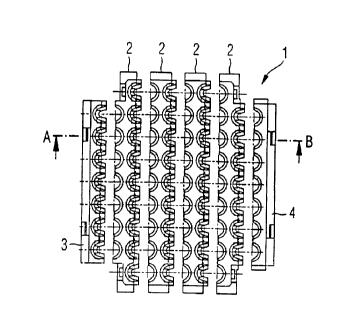Une partie des informations de ce site Web a été fournie par des sources externes. Le gouvernement du Canada n'assume aucune responsabilité concernant la précision, l'actualité ou la fiabilité des informations fournies par les sources externes. Les utilisateurs qui désirent employer cette information devraient consulter directement la source des informations. Le contenu fourni par les sources externes n'est pas assujetti aux exigences sur les langues officielles, la protection des renseignements personnels et l'accessibilité.
L'apparition de différences dans le texte et l'image des Revendications et de l'Abrégé dépend du moment auquel le document est publié. Les textes des Revendications et de l'Abrégé sont affichés :
| (12) Brevet: | (11) CA 2232566 |
|---|---|
| (54) Titre français: | PROCEDE DE MISE EN CONTACT D'UN CONNECTEUR A BANDE DE RACCORD FEMELLE |
| (54) Titre anglais: | METHOD FOR MAKING CONTACT WITH A MULTIPOLE FEMALE STRIP CONNECTOR |
| Statut: | Réputé périmé |
| (51) Classification internationale des brevets (CIB): |
|
|---|---|
| (72) Inventeurs : |
|
| (73) Titulaires : |
|
| (71) Demandeurs : |
|
| (74) Agent: | FETHERSTONHAUGH & CO. |
| (74) Co-agent: | |
| (45) Délivré: | 2002-08-20 |
| (86) Date de dépôt PCT: | 1996-09-10 |
| (87) Mise à la disponibilité du public: | 1997-03-27 |
| Requête d'examen: | 1998-03-19 |
| Licence disponible: | S.O. |
| (25) Langue des documents déposés: | Anglais |
| Traité de coopération en matière de brevets (PCT): | Oui |
|---|---|
| (86) Numéro de la demande PCT: | PCT/DE1996/001700 |
| (87) Numéro de publication internationale PCT: | WO1997/011512 |
| (85) Entrée nationale: | 1998-03-19 |
| (30) Données de priorité de la demande: | ||||||
|---|---|---|---|---|---|---|
|
La présente invention concerne un procédé permettant de mettre en contact un connecteur multipolaire à ressort destiné à la réalisation de connections par fiches avec des câbles de raccordement coaxiaux. Pour que le procédé soit simplifié et que le nombre d'outils soit limité, un connecteur à ressort à plusieurs rangées est divisé en disques de plastique, un côté de chaque disque présentant des éléments autodénudants placés l'un derrière l'autre et reliés à des ressorts de contact, et l'autre côté présentant des éléments de pression moulés par injection de façon à avoir une forme correspondante. Les disques sont espacés par des broches correspondantes insérées à ajustage serré. Des câbles de connexion coaxiaux coupés à la longueur désirée sont insérés dans ces disques prémontés et espacés, une longueur prédéfinie de l'isolation extérieure et de la tresse de blindage ayant été enlevée aux extrémités libres desdits câbles. Lorsque les disques sont pressés les uns contre les autres, les fils de connexion sont pressés contre l'élément autodénudant par les éléments de pression.
Method for making contact with a multipole female strip
connector
The present invention relates to a method for making
contact with a multipole female strip connector for plug
connections with coaxial connecting cables.
In order to simplify the method and to save
tools, a multi-row female strip connector is split into
plastic disks, one side of the disk having insulation-
piercing terminals which are arranged one behind the
other and are connected to contact springs, and the other
side having correspondingly formed, overmolded pressure
pieces. The disks are held spaced apart in a pressing
tool by means of corresponding press-in pins which have
a force fit. Coaxial connecting cables, which are cut to
length and at whose free ends the outer insulation and
the shield mesh have been removed over a predetermined
length, are pushed into these disks, which are
preassembled spaced apart. When the disks are pressed
together, the pressure pieces press the connecting wires
into the insulation-piercing terminal.
Note : Les revendications sont présentées dans la langue officielle dans laquelle elles ont été soumises.
Note : Les descriptions sont présentées dans la langue officielle dans laquelle elles ont été soumises.

Pour une meilleure compréhension de l'état de la demande ou brevet qui figure sur cette page, la rubrique Mise en garde , et les descriptions de Brevet , États administratifs , Taxes périodiques et Historique des paiements devraient être consultées.
| Titre | Date |
|---|---|
| Date de délivrance prévu | 2002-08-20 |
| (86) Date de dépôt PCT | 1996-09-10 |
| (87) Date de publication PCT | 1997-03-27 |
| (85) Entrée nationale | 1998-03-19 |
| Requête d'examen | 1998-03-19 |
| (45) Délivré | 2002-08-20 |
| Réputé périmé | 2004-09-10 |
Il n'y a pas d'historique d'abandonnement
| Type de taxes | Anniversaire | Échéance | Montant payé | Date payée |
|---|---|---|---|---|
| Requête d'examen | 400,00 $ | 1998-03-19 | ||
| Enregistrement de documents | 100,00 $ | 1998-03-19 | ||
| Le dépôt d'une demande de brevet | 300,00 $ | 1998-03-19 | ||
| Taxe de maintien en état - Demande - nouvelle loi | 2 | 1998-09-10 | 100,00 $ | 1998-08-17 |
| Taxe de maintien en état - Demande - nouvelle loi | 3 | 1999-09-10 | 100,00 $ | 1999-08-12 |
| Taxe de maintien en état - Demande - nouvelle loi | 4 | 2000-09-11 | 100,00 $ | 2000-08-18 |
| Taxe de maintien en état - Demande - nouvelle loi | 5 | 2001-09-10 | 150,00 $ | 2001-08-16 |
| Taxe finale | 300,00 $ | 2002-06-06 | ||
| Taxe de maintien en état - brevet - nouvelle loi | 6 | 2002-09-10 | 150,00 $ | 2002-08-16 |
Les titulaires actuels et antérieures au dossier sont affichés en ordre alphabétique.
| Titulaires actuels au dossier |
|---|
| SIEMENS AKTIENGESELLSCHAFT |
| Titulaires antérieures au dossier |
|---|
| SEIBOLD, JURGEN |
| SEIDEL, PETER |
| ZELL, KARL |